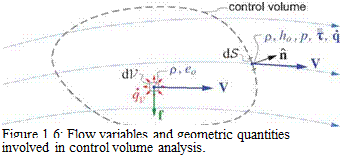Integral conservation laws
 |
A general control volume placed in a flow-field is shown in Figure 1.6, with dV being an interior volume element, and dS being a boundary surface area element with outward unit normal n.
Integral mass equation
The law of conservation of mass asserts that the time rate of change of the total mass in the volume, plus the net mass outflow rate through the surface of the volume, must sum to zero.
The second mass outflow term is seen to be the integral of the mass flux over the volume’s surface area.
Integral momentum equation
Similarly, the law of conservation of momentum, or equivalently Newton’s Third Law, asserts that the time rate of change of the total momentum in the volume, plus the net momentum outflow rate through the surface of the volume, must sum to the total force acting on the interior and the surface of the volume.
Integral energy and enthalpy equations
The law of conservation of energy, or equivalently the First Law of Thermodynamics, asserts that the time rate of change of total energy, plus its net outflow rate, equals the sum of heat and work sources qV+wv in the interior, plus heat inflow and work — qS+wS at the boundary. The work terms are written out explicitly.
 |
|||
We then combine the lefthand energy-flux and righthand pressure-work terms together into an enthalpy flux term on the left, and replace peo with pho—p in the unsteady term, giving the alternative integral enthalpy equation.














